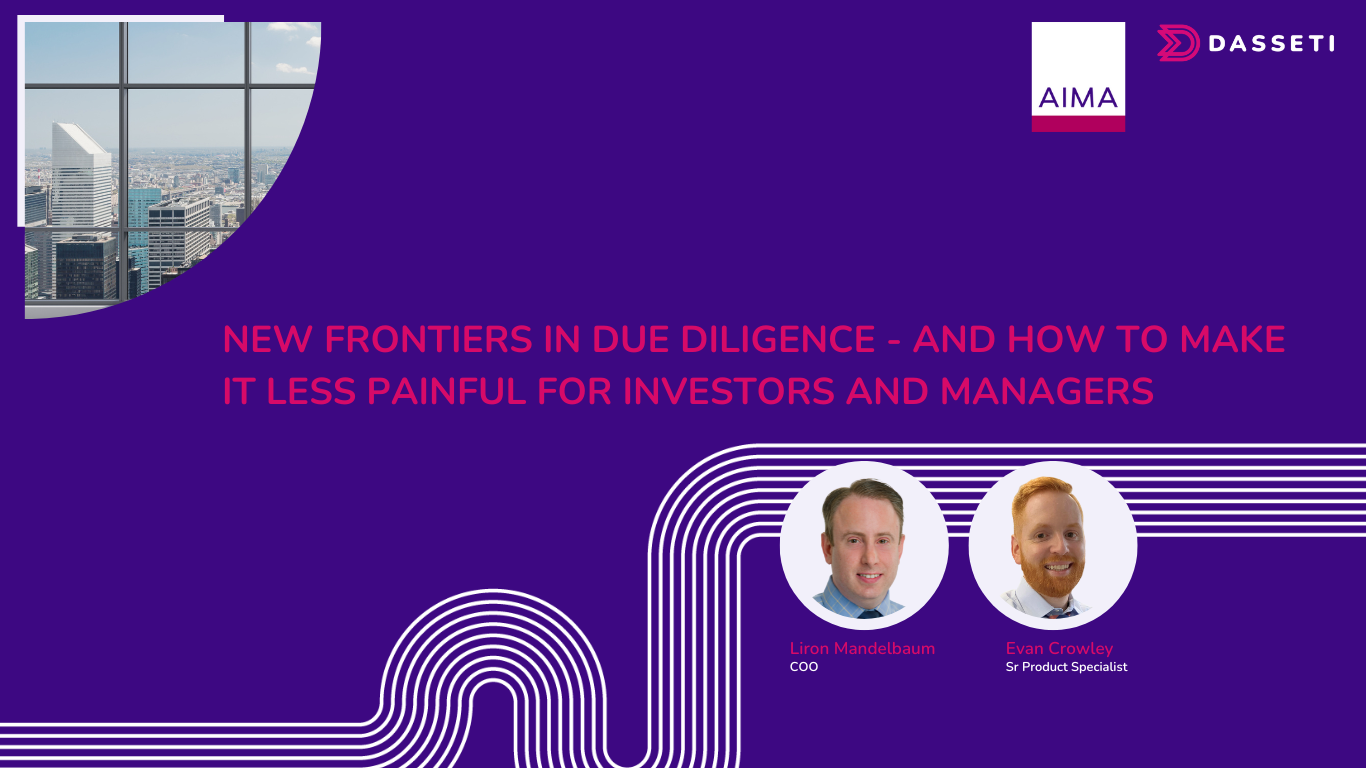This blog summarizes key insights from our recent webinar with AIMA titled "New Frontiers in Due Diligence" featuring Liron Mandelbaum, COO and Evan Crowley, Sr Product Specialist with AIMA moderator Michelle Noyes, Head of Americas.
The Humble Beginnings of Due Diligence
Due diligence questionnaires (DDQs) have come a long way from their humble beginnings. When the first DDQ was introduced decades ago, it was a slim 10 pages - and even that was considered overly burdensome at the time! Fast forward to today, and DDQs now routinely span hundreds of pages with multiple modules as the due diligence process has grown exponentially more complex. This explosion in requirements has strained limited partners (LPs) and general partners (GPs) as they struggle to adapt manual workflows. However, exciting new technologies promise to help streamline due diligence for all parties.
Forces Driving Due Diligence Expansion
Two key factors are driving the expansion of due diligence. First, transparency regulations have increased, especially for alternatives like private equity and hedge funds. Mandatory reporting forms in the US and Europe have added requirements, alongside growing qualitative scrutiny around ESG metrics.
Second is the mandatory participation required of GPs. As investors demand more details to fulfill their fiduciary responsibilities, DDQs have become compulsory for any GP seeking institutional capital. Amidst this heightened participation, LPs want assurance they are covering all relevant topics and asking the right due diligence questions. Many turn to industry resources like AIMA’s DDQs, which leverage years of expertise to provide best practice due diligence tailored for each asset class.
The Rising Prominence of ESG Metrics
A particular area of growth has been around ESG-related questions. Historically, the focus was on quantitative environmental data like emissions and resource usage. However, metrics around social impact, diversity, inclusion, and governance have taken on greater prominence. This qualitative data is harder to capture but essential for understanding systemic risks.
Pain Points of Due Diligence Growth
While this growth in due diligence is necessary, it has also created significant pain points for LPs and GPs alike:
- On the LP side, manual processes often result in a deluge of thousands of emails and Excel spreadsheets from GPs that must be analyzed, reconciled, and combined. For a large pension or sovereign wealth fund, this can take months of human capital across analysts, delaying decision-making.
- For GPs, the explosion of DDQs disrupts operations, distracts personnel, and strains investor relations teams attempting to respond to myriad overlapping questions from different LPs. The process also recurs in cycles throughout the year, leading to crunch times that are dreaded by all.
How Technology Can Streamline Due Diligence
Excitingly, new technologies like artificial intelligence and process digitization promise to streamline due diligence for both LPs and GPs:
- For LPs, advanced natural language processing can provide an initial automated review of DDQ responses, flagging any critical issues for human analysts to hone in on. This could reduce the grunt work by 30-40%, freeing up time for value-added interpretation. Consolidated data also reduces duplication requests across groups.
- For GPs, AI solutions help centralize institutional knowledge so DDQ responses can be tailored faster without losing oversight. With large language models, answers don't need to match questions word-for-word. Automated reminders to subject matter experts also simplify the complex task of maintaining an up-to-date Q&A bank.
- Across both LPs and GPs, digitization facilitates tracking and internal coordination around the due diligence process. With a unified platform, there is complete visibility into outstanding questions, required approvals, and pending information requests. This avoids duplication, ensures compliance oversight, and keeps investment professionals in the loop.
At the same time, human input remains critical for nuanced interpretation of DDQ responses and building investor relationships. The key is using AI to free up professionals to focus their time on these higher-value activities.
Adoption Challenges and Inflection Points
Legacy processes also pose challenges to digitization. Change requires upfront investment and coordination across stakeholders who may be ingrained in existing manuals workflows. Startup funds may lack the scale for comprehensive tech solutions. And LPs want assurance that GPs will actually adopt new technology for the benefits to fully materialize.
Often the turning point comes when a GP decides to target institutional capital. Servicing large pension funds, insurers, and sovereign wealth funds requires much more efficient and consistent due diligence capabilities. For emerging managers, this inflection often comes in the second or third fund. Though change takes effort and education, advanced solutions allow firms to modernize workflows rather than simply adding more headcount.
The Future is Bright for Digitized Due Diligence
In summary, due diligence requirements have grown vastly more complex over the years, but technology makes comprehensive, end-to-end digitization achievable. AI, as a co-pilot to human expertise, and unified platforms give LPs and GPs alike more control, flexibility, and analytical power around due diligence. While adopting these solutions requires an initial mindset shift, those who modernize can focus resources on high-value partnerships and activities rather than repetitive tasks. With the right foundation, due diligence can evolve from a pain point to a core competitive advantage.
Want to learn more? Be sure to check out the full webinar recording, where we talk about the impacts of generative AI, new regulations and how to streamline the DDQ process.
